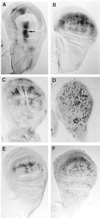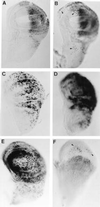Developmental parameters of cell death in the wing disc of Drosophila
- PMID: 9159134
- PMCID: PMC20840
- DOI: 10.1073/pnas.94.11.5691
Developmental parameters of cell death in the wing disc of Drosophila
Abstract
Apoptotic cell death in wing imaginal discs takes place in single cells or small clusters of neighboring cells. These cells are distributed throughout the anlage at early stages and in recognizable territories at late larval and pupal stages. Apoptotic cells remain in the epithelium 2-4 h, prior to being engulfed in place by hemolymph cells. Experimentally induced apoptosis in single cells or territories is accompanied by nonautonomous death of adjacent cells and of cells further away in adjacent territories. These effects are followed by changes in cell proliferation in both territories. Apogenetic mosaics in mutant discs show cell death throughout the anlage. Apoptosis provides a mechanism, in addition to cell proliferation control, for matching territories with different positional values or different genetic specifications.
Figures





References
-
- Jacobson M D, Weil M, Raff M C. Cell. 1997;88:347–354. - PubMed
-
- Raff M C. Nature (London) 1992;356:397–400. - PubMed
-
- Wolff T, Ready F. Development (Cambridge, UK) 1991;113:825–839. - PubMed
-
- White K, Grether M E, Abrams J M, Young L, Farrell K, Steller H. Science. 1994;264:677–683. - PubMed
-
- Grether M E, Abrams J M, Agapite J, White K, Steller H. Genes Dev. 1995;9:1694–1708. - PubMed
Publication types
MeSH terms
Substances
LinkOut - more resources
Full Text Sources
Molecular Biology Databases

